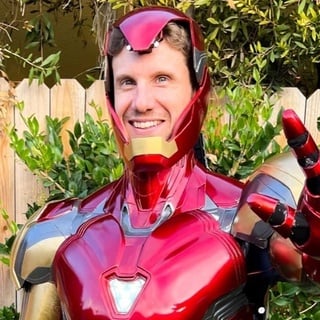You need to hire. We're here to help.
Find and hire top 3D Animators, fast.
Get matched to 3 highly-qualified 3D Animators in minutes.
Hire Top 3D Animators.png)
.png)
.png)
How to hire top 3D Animators at Braintrust
Post a job
Create an account and publish your job posting free of charge.
Review candidates
Manage and hire top talent instantly.
Get to work
We simplify onboarding, invoicing, compliance, and more.
Meet our 3D Animator community
Braintrust is a user-owned talent platform created by and for the world’s top talent. This includes a talented network of experienced 3D Animators available for hire.
Looking for Work

JJ Chalupnik Chalupnik
- 3D Modeling
- Video Editing
Looking for Work

Michael Morris Morris
- 3-D Animation
- 3D Modeling
Looking for Work

Shaun Hamm
- 3D Modeling
- Photoshop
How to hire Top 3D Animators

Overview
Hiring a 3D animator can be a significant step, whether it's for a burgeoning startup or a well-established company. While the fundamental skills required remain the same - technical proficiency, artistic sensibility, understanding of animation principles, and a compelling portfolio - the specifics can vary widely depending on the company size, work scope, and employment type.
In a startup environment, a 3D animator may need to be a jack-of-all-trades, handling multiple aspects of a 3D design project from modeling to rendering, due to resource constraints. They might need a wider set of skills, creativity, adaptability, and a willingness to take on varied tasks. At larger companies, the roles are often more specialized, allowing animators to focus on specific areas like character animation, lighting, or texturing. These companies typically look for deeper expertise in a particular area, along with the ability to collaborate effectively in a larger team.
Choosing between hiring full-time or hourly depends largely on the company's project pipeline. Full-time employees are generally a better fit for long-term projects and ongoing work, providing continuity and deeper involvement. They are typically more invested in the company's culture and long-term goals.
On the other hand, hourly or contract-based animators might be a more viable choice for short-term projects or for adding extra capacity during peak periods. They offer flexibility, and can be more cost-effective if the work is project-based with quiet periods in between. However, keep in mind that freelance or contract workers may be juggling multiple clients and might not be as immersed in your company culture or specific project.
Regardless of the context, effective hiring practices require a careful review of the candidate's portfolio to assess their style and technical skills. Consider conducting practical tests or trials, if possible, to gauge their skills and see how they work under realistic conditions.
Open communication about expectations, project timelines, compensation, and feedback mechanisms are vital for a successful hiring process. The ideal candidate will not only have the necessary skills and experience but also fit with your company culture and share your team’s values and work ethic.
Hiring a 3D animator is an investment that can add immense value to your projects, bringing concepts and ideas to life in a dynamic and engaging way. It's worth the effort to find the right person or team that matches your creative vision and can deliver quality work consistently, whether you're a startup or a larger company, and whether you're hiring full-time or on an hourly basis.
Technical Proficiency
Technical proficiency is fundamental for a 3D animator. An animator needs to master various tools and software to create 3D models, apply textures and lighting, animate characters, and render final outputs. Industry-standard software includes Autodesk's Maya and 3DS Max, Blender, and Cinema 4D. These programs facilitate 3D modeling, rigging, animation, simulation, rendering, compositing, and motion tracking. Moreover, proficiency with Adobe Photoshop and After Effects is beneficial for texturing and post-production tasks. In addition to software, an understanding of programming languages like Python can also be useful for scripting and automating tasks.
Artistic Sensibility
Beyond the technical skills, 3D animators must have a strong artistic sense. They need to understand basic art and design principles, including color theory, composition, perspective, and anatomy. Understanding how different colors evoke emotions can significantly impact the mood of a scene. They should have a keen eye for detail to create visually pleasing and realistic scenes and characters. Experience with traditional drawing or sculpting can enhance their understanding of form, structure, and gesture, which are essential in 3D modeling and character animation. Using a digital drawing tablet is often part of the workflow for creating textures or sketching out ideas.
Understanding of Animation Principles
A good 3D animator has a deep understanding of the 12 principles of animation developed by Disney. These principles guide the animator in creating more realistic and expressive motion. For instance, 'Squash and Stretch' gives weight and flexibility to objects. 'Anticipation' prepares the viewer for an action that is about to happen. 'Staging' presents an idea so that it is unmistakably clear. 'Straight Ahead Action and Pose-to-Pose' are two different approaches to the drawing process. 'Follow Through and Overlapping Action', 'Slow In and Slow Out', 'Arc', 'Secondary Action', 'Timing', 'Exaggeration', 'Solid Drawing', and 'Appeal' are other principles. Understanding these principles in addition to 2d animation requires both theoretical knowledge and practice.
Portfolio/Reel
An animator’s portfolio is the tangible evidence of their skills, creativity, and style. It's a compilation of their best work and should demonstrate their proficiency in various aspects of 3D animation, such as modeling, 3D product design, texturing, rigging, lighting, and animation. When reviewing a demo reel or portfolio, look for the complexity of the scenes, the quality of the animations, the lighting, and the overall visual aesthetics. It’s also essential to consider the relevance of the work to your project. For instance, if you're hiring for a game development project, a portfolio that showcases great character animations and game environment models would be more relevant compared to one primarily focused on architectural renderings.
Creativity and Originality
Creativity is a key trait for any 3D Artist. Each project presents its own unique set of challenges, and it's often up to the animator to find innovative solutions. This creativity extends to character design, environmental design, and storytelling. It's also tied to the animator's ability to create fresh, engaging visuals that stand out from the crowd. This requires not only an active imagination but also a thorough understanding of visual art and design principles. Tools like mind-mapping software or digital sketchbooks can be valuable for brainstorming and developing ideas. Furthermore, keeping up-to-date with the latest trends and technologies in animation can inspire fresh and original approaches.
Communication Skills
Animation is often a collaborative effort, involving a team of artists, designers, and other specialists. As such, effective communication is critical. Animators need to articulate their ideas clearly, take direction well, and be open to feedback. They also need to communicate technical information to non-technical team members. These communication skills can be developed through experience in team projects, workshops, and courses. Familiarity with project management and communication tools like Slack, Trello, or Microsoft Teams can also be valuable.
Problem-Solving Skills
3D animation is a complex field that often involves unexpected technical challenges. An animator may need to figure out why a model isn't rendering correctly, how to rig a difficult character, or how to make an animation look more realistic. Animator jobs require a logical, methodical approach to problem-solving, and may also involve researching online forums, software help documents, and tutorials to find solutions. Knowledge of debugging, formats, hardware limitations, and software glitches is beneficial. Patience and perseverance are also critical, as solutions may not always be immediately evident.
Experience and Education
While talent can certainly be self-taught, formal education in a relevant field like animation, graphic design, or fine arts can be a strong indicator of an animator's foundational knowledge. Degree programs typically provide comprehensive training in technical skills, art principles, and industry-standard software, and they also offer opportunities for feedback from experienced professionals. However, practical experience is equally important. This can include professional experience in a studio, freelance projects, internships, or even personal projects. Real-world experience demonstrates an animator's ability to apply their skills in a practical context, meet deadlines, and handle the pressures of the industry. For hiring managers, the combination of relevant education and practical experience often signifies a well-rounded, capable candidate.
Expert Resources for Hiring 3D Animators
Frequently Asked Questions
How much does it cost to hire a 3D Animator?
The cost to hire a 3D animator can vary widely based on factors such as the animator's experience, the complexity of the project, and geographical location. In the United States, the average annual salary for a 3D animator was around $75,000, with more experienced animators earning over $100,000. However, rates can vary significantly globally. Remember that these are averages and costs may have changed.
Where can I hire a 3D Animator?
You can hire a 3D animator through various channels. Job posting websites like LinkedIn, Indeed, social media, or Glassdoor can be useful for finding full-time candidates. You could also consult a recruiter. To hire 3D animation freelancers or contract work, platforms like Braintrust, host many high-quality 3D animators. Networking at industry events or reaching out to animation schools can also yield potential candidates.
How do I recruit a 3D Animator?
Recruiting a 3D animator involves defining the job requirements and responsibilities clearly. Start with creating a detailed job description, highlighting the required skills and experiences, and describing the project or type of work. Post this job description on relevant platforms, and make use of industry networks. Once applications start coming in, screen the candidates based on their portfolio and resume. A test project or assignment can be helpful in gauging their skills. Conduct interviews to assess their communication skills, cultural fit, and understanding of your project.
How much does a 3D Animator charge per hour?
Hourly rates for 3D animators can vary significantly based on their years of experience, the complexity of the work, and the region. In the United States, freelance 3D animators could charge anywhere from $25 per hour for less experienced animators to $100 or more per hour for highly experienced ones. However, these rates can be significantly different in other countries. Always ensure to discuss and agree on rates before beginning a project.
What does a 3D animator do?
A 3D animator creates three-dimensional moving images using digital models. Their work begins with the creation or manipulation of a digital object or character, which is then rigged with a digital skeleton for movement. By applying the principles of animation, they bring these models to life, creating the illusion of movement. They work on different aspects like texturing, lighting, and rendering to make the animations more realistic. These animations are used in various industries, including film and television, video games, animation video, industrial design, logo animation/logo design, advertising, and virtual reality. 3D animators may also collaborate with other creative professionals, such as directors and game designers, to realize a shared vision.
Is 3D animation a good career?
3D animation can be a rewarding career for those with a passion for art, graphic design, and technology. The demand for skilled 3D animators has grown with the rise of digital media, gaming, and virtual/augmented reality experiences. The field offers opportunities for creativity and innovation and can provide a sense of accomplishment as you see your creations come to life. However, it's also a field that requires dedication, ongoing learning, and often long hours. Competition can be fierce, and meeting project deadlines can be stressful. However, for many, the ability to work on exciting projects, from animated films to cutting-edge video games, outweighs these challenges.
What skills are required for 3D animation?
3D animation requires a blend of artistic and technical skills. On the artistic side, an understanding of color, light, shadow, and composition is crucial, along with a strong sense of motion and timing. Technical skills involve proficiency in 3D animation software like Maya, 3DS Max, SketchUp, adobe after effects, video editors, or Blender. These tools are used for modeling, rigging, animating, texturing, lighting, and rendering. Also, understanding the 12 principles of animation is essential to create fluid, realistic movement. Beyond these, problem-solving skills, creativity, good communication, and the ability to work in a team are valuable traits in this profession.
How do you become a 3D animator?
Becoming a 3D animator typically starts with gaining a strong foundation in art and design principles. Many animators pursue a degree in animation, graphic design, fine arts, or a related field, though some might be self-taught. These programs often provide training in essential software tools and animation techniques. Building a strong portfolio is crucial for showcasing your skills and creativity to potential employers. This usually involves working on various personal or school projects. Internships can provide valuable real-world experience and networking opportunities. Staying updated with the latest industry trends and continually learning new software and techniques is also important in this rapidly evolving field.
Get matched with Top 3D Animators instantly 🥳
Hire Top 3D Animators


.webp)

.webp)





